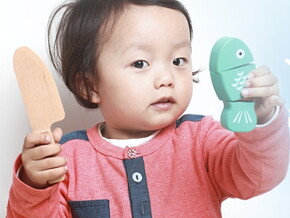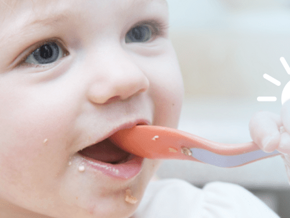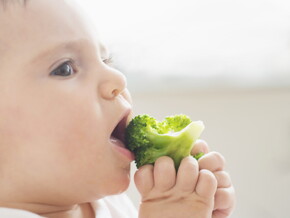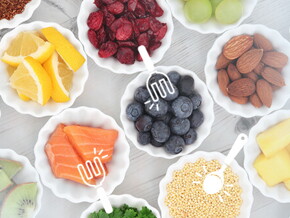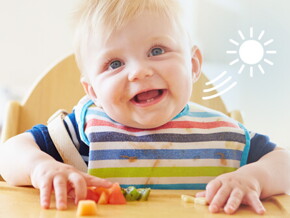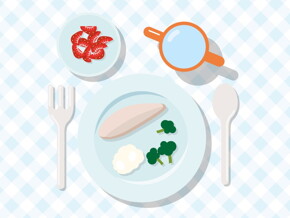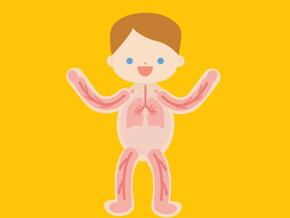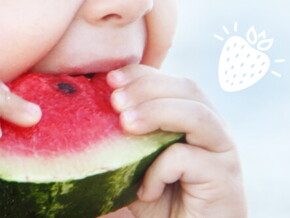
1. Consider how you feed your child
Take a moment to think about feeding occasions with your toddler. Are you following the principles of responsive feeding—creating a warm, positive environment for family meals, respecting your toddler’s decision of whether to eat and how much, and leading by example when it comes to varied and nutritious food choices? If you are, great! However, if you recognize yourself falling into some of the less desirable feeding behaviours listed below, now’s the time to remind yourself of all the benefits of responsive feeding. Remember, it’s not just about what and how much your toddler eats. The way you offer food is essential for his healthy eating habits too.
Responsive feeding is the way to go. As well as reducing the potential for overeating, responding to your toddler’s hunger and fullness cues is linked to a healthier diet and body weight. Responsive feeding means pleasant and engaging mealtimes, without putting too much pressure on your toddler or encouraging him excessively. Parents who follow the principles of responsive feeding also offer their toddler healthy food choices at meals and snack times, set clear guidelines and expectations at mealtimes and are good role models by practicing and promoting healthy eating at home. - What Dr. Fries says
2. Be careful not to pressure
You probably have a clear idea of how much you want your toddler to eat. Perhaps you even push them to finish it all, even when they tell you they’re full. Just because you’re the adult, it doesn’t mean you know best when it comes to your little one’s appetite. Let your toddler decide how much they will eat.
Forcing your child to eat more foods than they want can have a variety of consequences. If your child is full, this can teach them to ignore their fullness cues, potentially leading to overeating in the future. In other cases, it can create a stressful environment, leading to negative associations with the food you want them to eat—potentially making them avoid it in the future. Children may eat more one day than another, and that’s OK; they’ll make up for it at another meal. - What Dr. Fries says
3. Offer nutrient-rich foods and drinks
Your toddler’s tummy is small, so it’s important that precious space isn’t taken up by foods that are high in salt and sugar, or with sugar-sweetened beverages. Instead, offer a variety of foods that are rich in nutrients, along with milk (breast milk, whole cow’s milk) or water with every meal and snack. When sweets and desserts are served, offer them in toddler-sized portions. Practice responsive feeding by not pressuring them to eat these foods, but also try to be relaxed about them having a taste. Your toddler will soon learn that sweet treats are fun and not part of their everyday diet.
Research in older children shows that when parents restrict what their children can eat (such as saying certain foods are never allowed), it makes certain foods more attractive because they are "forbidden", and children may be more likely to overindulge in these foods when given the chance. - What Dr. Fries says
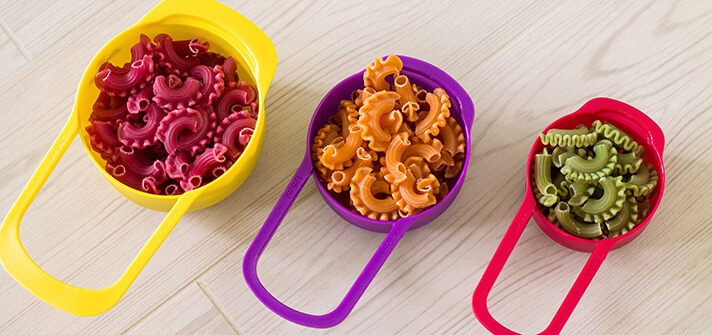
4. Check portion sizes
Serve age-appropriate amounts of food. You can always offer them more if they shows signs of still being hungry after finishing their food. Avoid encouraging them to “clean up your plate” and instead respect their hunger and fullness cues.
There is evidence that providing large portions of appetizing, energy-dense foods increases the amount a child eats. - What Dr. Fries says
5. Encourage gently
When introducing a new food, a few words of encouragement can help convince your toddler to give it a try.
In one recent study, very few children were willing to try a new fruit or vegetable without encouragement. Rather than tricks or bribery, with a gentle parental suggestion to “try the peas”, a child will be more likely to taste the food. - What Dr. Fries says

6. Be a good role model
As often as possible, sit down as a family to enjoy a meal together. Your toddler learns from what they see you and other family members doing, so be a good role model by eating and enjoying healthy food. Let them see you eating a new food with pleasure and chances are they’ll want to give it a taste too.
What a parent eats is a powerful predictor of what a child eats. One recent study showed that modeling eating a food was the most successful technique to convince a child to eat something. - What Dr. Fries says
7. Banish the bribery
As tempting as it might be, don’t use food as a reward. Offering your toddler ice cream if they eat their vegetables, for instance, could create negative associations and put them off vegetables in the long term.
Try to offer all foods equally rather than give them the idea that some foods are less appetizing, and others are more appealing. - What Dr. Fries says
8. Prevent “picky eating”
Sometimes, you might feel so worried that your toddler is turning into a picky eater, only eating a limited range of foods, that you desperately plead with them to eat. This can make mealtimes stressful for you both and have the opposite effect of what you’re hoping for. If they only like a few foods, put some of those on their plate alongside new or previously rejected foods. Children may have to taste a new food several times before they learn to like it.
Research shows that pressuring toddlers to eat any type of food actually makes them more likely to refuse it. If parents can keep a relaxed attitude towards eating, children may be more likely to taste foods. - What Dr. Fries says
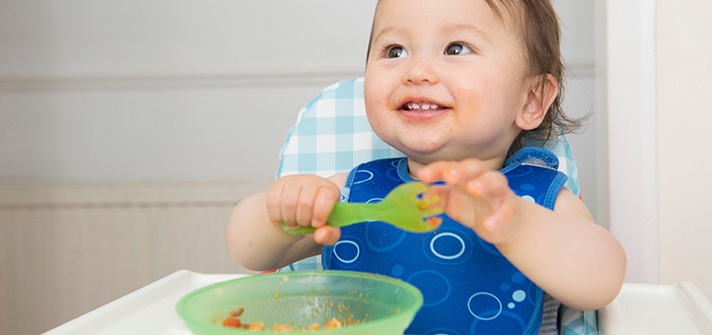
9. Take time to chew
Offer your toddler food in small, bite-size pieces and make sure they have chewed what’s in their mouth before you offer more. Also, don’t rush your toddler to finish their meal. Let them eat at their own pace. Getting into good habits now may help avoid future problems of overeating.
Children who eat faster tend to consume more calories. This can be due to taking larger bites and chewing their food less. Research shows that these tendencies toward faster eating can emerge in preschoolers. - What Dr. Fries says
10. Avoid using food to soothe
At this age, your little one may not have enough language skills to communicate their feelings with words, so may get frustrated and act out or have a tantrum. It can be tempting to bring out the emergency cookie, particular favourite food, or even a healthy snack to try to prevent a scene. However, this can have negative consequences in the long run.
Using food to soothe from an early age may contribute to the development of obesity in young children. Toddlers could begin to connect food with emotions instead of their own appetite cues, prompting them to eat when they’re not hungry. - What Dr. Fries says
11. Remember that there’s no “perfect-sized” toddler
Don’t try to pressure a smaller toddler to eat more or withhold food from a bigger toddler in an effort to help him lose weight. It is a misconception that bigger babies are healthier babies.
Babies are born with natural instincts to recognize their own hunger and fullness. Respecting and responding to your child’s hunger and fullness cues leads to healthier eating habits and growth. - What Dr. Fries says

12. Learn to “read” your toddler
Avoid putting too much food on your little one’s plate. Offer them a small portion and pay attention to signs from them that tell you if they’re full or still hungry. You can always offer them another small portion if they show you that they are still hungry.
At 18-24 months of age, toddlers can use a combination of words (such as ‘want that’ or ‘all done’) and gestures (pointing, reaching, or pushing the food away) to let you know when they are hungry and full. Look out for these gestures and expressions, and listen to what they tell you when it comes to their appetite. - What Dr. Fries says
13. Allow time for your toddler to practice chewing
By now your little one has likely moved on from lumpy purees to chopped family foods. You’ll still need to cut up food into bite-size pieces as they learn how to chew.
From birth to age four, children’s mouths double in volume. Their chewing muscles become stronger, allowing finer control of the food in their mouths. Learning to chew with appropriate textures has many effects on their overall eating experience, from taste, smell, and texture perception to feeling full and accepting a wider range of foods. - What Dr. Fries says

14. Make mealtimes fun!
Try getting your toddler involved in the cooking—there are many age-appropriate cooking tasks toddlers can help with, such as rolling out dough, snapping broccoli florets off the stalk, scrubbing potatoes, and pouring ingredients into a bowl. Make sure your toddler is supervised in the kitchen at all times. Your toddler will look forward to family meals that they have helped prepare.
Sources
Birch LL, Savage JS, Fisher JO. Right sizing prevention. Food portion size effects on children’s eating and weight. Appetite 2015; 88:11-16.
Black RE, Makrides M, Ong KK (eds): Complementary Feeding: Building the Foundations for a Healthy Life. 2017 Nestlé Nutr Inst Workshop Ser, vol 87, pp 153–165, (DOI: 10.1159/000448965)
Blissett J, Fogel A. Intrinsic and extrinsic influences on children’s acceptance of new foods. Physiol Behav 2013; 121:89–95.
Dattilo AM Programming long-term health: Effect of parent feeding approaches on long-term diet and eating patterns. In: Early nutrition and long-term health, mechanisms, consequences and opportunities. Ed., Saavedra and Dattilo, Elsevier, 2017: 471-95.
Edelson LR, Mokdad C, Martin N. Prompts to eat novel and familiar fruits and vegetables in families with 1-3 year-old children: Relationships with food acceptance and intake. Appetite 2016: 99:138-48.
Fogel A, Goh AT, Fries LR, et al. A description of an ‘obesogenic’ eating style that promotes higher energy intake and is associated with greater adiposity in 4.5 year-old children: Results from the GUSTO cohort. Physiol Behav 2017; 176:107-16.
Fogel A, Goh AT, Fries LR, et al. Faster eating rates are associated with higher energy intakes during an ad libitum meal, higher BMI and greater adiposity
among 4.5-year-old children: results from the Growing Up in Singapore Towards Healthy Outcomes (GUSTO) cohort. Br J Nutr 2017; 117(7):1042-51.
Fogel A, Fries LR, McCrickerd K, et al. Oral processing behaviours that promote children’s energy intake are associated with parent-reported appetitive traits: Results from the GUSTO cohort. Appetite 2018:126:8-15.
Fries LR, Martin N, van der Horst K. Parent-child mealtime interactions associated with toddlers’ refusal of novel and familiar foods. Physiol Behav 2017; 176:93-100.
Le Reverend BJD, Edelson LR, Loret C. Anatomical, functional, physiological and behavioural aspects of the development of mastication in early childhood. Br J Nutr 2014, 111(3):403–14.
Perez-Escamilla R, Segura-Perez S, Lott M, on behalf of the RWJF HER Expert Panel on Best Practices for Promoting Healthy Nutrition, Feeding Patterns, and Weight Status for Infants and Toddlers from Birth to 24 Months. Feeding Guidelines for Infants and Young Toddlers: A Responsive Parenting Approach. Durham, NC: Healthy Eating Research, 2017. Available at: http://healthyeatingresearch.org
Rodgers RF, Paxton SJ, Massey R, et al. Maternal feeding practices predict weight gain and obesogenic eating behaviors in young children: a prospective study. Int J Behav Nutr Phys Act 2013; 10:24 http://www.ijbnpa.org/content/10/1/24
Russell CG, Haszard JJ, Taylor RW, et al. Parental feeding practices associated with children’s eating and weight: What are parents of toddlers and preschool children doing? Appetite 2018; 128:120-8.
Shloim N, Edelson LR, Martin N, et al. Parenting styles, feeding styles, feeding practices, and weight status in 4-12 year-old children: A systematic review of the literature. Front Psychol 2015; 6:1849. doi: 10.3389/fpsyg.2015.01849
Stifter CA, Moding KJ. Understanding and measuring parent use of food to soothe infant and toddler distress: A longitudinal study from 6 to 18 months of age. Appetite 2015; 95:188-96.
van der Horst K, Sleddens EFC. Parenting styles, feeding styles and food-related parenting practices in relation to toddlers’ eating styles: A cluster-analytic approach. PLoS ONE 2017; 12(5): https://doi.org/10.1371/journal.pone.0178149
Vollmer RL, Mobley AR. Parenting styles, feeding styles, and their influence on child obesogenic behaviors and body weight: a review. Appetite 2013; 71:232-41.
Woo Baidal JA, Morel K, Nichols K, et al. Sugar-sweetened beverage attitudes and consumption during the first 1000 days of life. Am J Public Health 2018; 108(12):1659-65. doi:10.2105/AJPH.2018.304691





